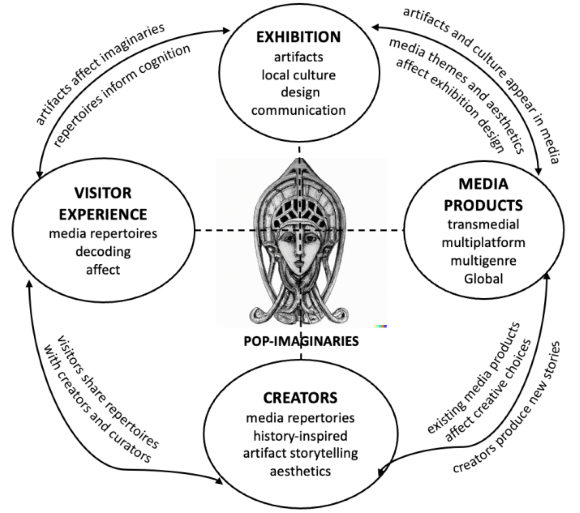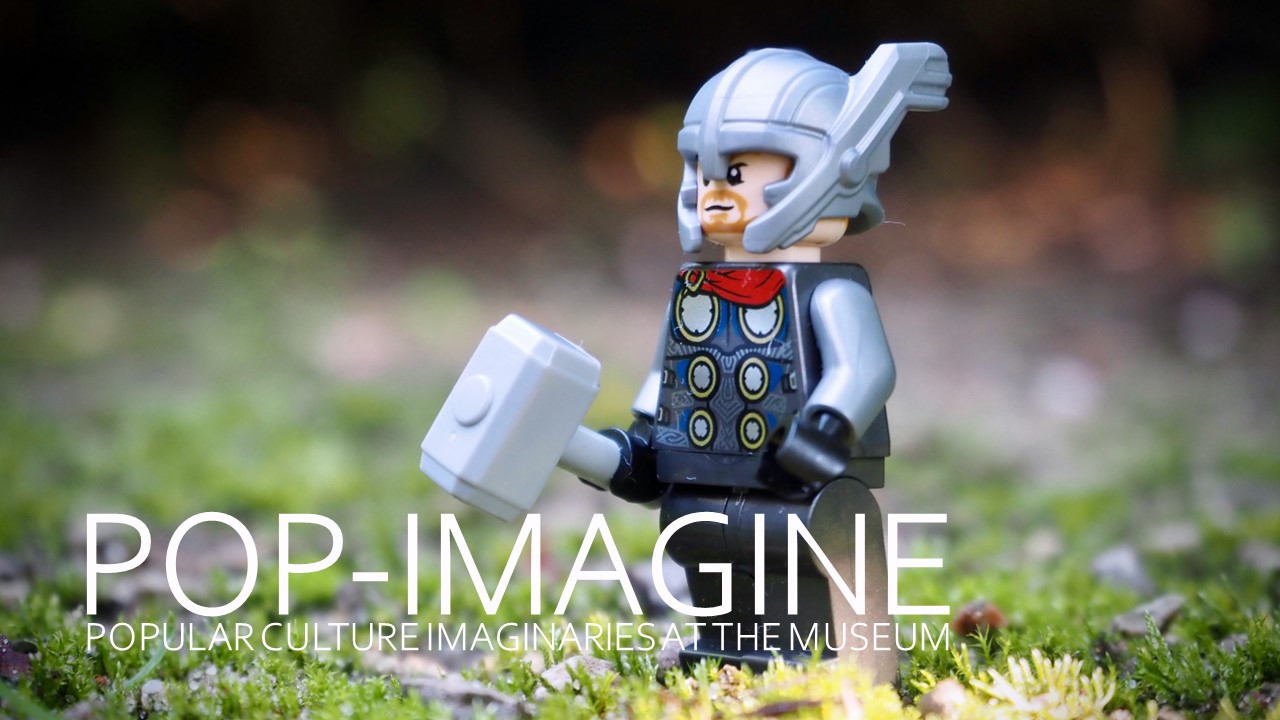Popular culture goes to the museum
Popular culture mediascapes draw inspiration from cultural heritage, and so we meet Vikings and Ancient Egyptians on our streaming platforms, at the library, in computer games, and even on social media. When works of popular culture are repurposed in a global transmedia ecology, they acquire new meanings and further shape our imaginaries. These popular culture imaginaries in turn shape the knowledge and expectations that audiences bring with them when visiting ethnographic and historical museums, defying historical facts and scientific evidence (Wintle 2017) and producing alternative epistemologies (Lewandosky et al. 2017). At the same time, contemporary exhibition design is often inspired by the themes and aesthetics of popular culture, sometimes generating controversy, like Jim Lyngvild’s Vikings exhibition illustrates (Sindbæk 2018).
In our hypermediated society, popular culture imaginaries affect the meaning-making operations of both producers and receivers, shaping exhibition design and communication practices as well as visitors' experiences. Since different kinds of knowledge and experience are becoming increasingly intertwined, it is imperative for cultural institutions to learn how to engage them, to capitalize on them but also avoid pitfalls.
POP-IMAGINE proposes to investigate the reciprocal relationship between popular media products and cultural heritage by focusing on popular culture imaginaries from a creator, museum, and audience perspectives.
Objectives and research questions
The project’s objective is to investigate the role that popular culture imaginaries play in shaping the modern museum, focusing both on processes of museum-making and museum-experiencing. Our point of departure is an applied empirical investigation of the (trans)mediated contexts around two exhibitions with strong connection to popular culture imaginaries: Vølven and Ancient Egypt: The Realm of Osiris. This very concrete investigation will ground our main research question:
How are popular culture imaginaries constituted, repurposed and received in the making and experiencing of cultural history exhibitions?
This research question highlights how popular culture imaginaries are both a product of media consumption and generators of experiential frames and creative inspiration, both for media creators, museum curators and audiences. Pop-imaginaries are produced in a complex interaction along four dimensions:

Each of these four dimensions is explored in their own subproject. The subprojects will inform each other and are thus intricately connected.
Subprojects
SP1 – Fieldworking the Museum
Christian Hviid Mortensen and Nanna Holdgaard
The objective of this subproject is to investigate if and how popular culture imaginaries play a part in the design and staging of the two exhibitions in focus. We will draw on Willig’s adoption of Bourdieu’s Field Theory as analytical framework for the study of media production (Willig 2012, 2016), as it can uncover understandings otherwise taken for granted. In the data collection we will examine any traces of popular culture imaginaries of the final products through multimodal exhibition analysis (Roppola 2012) and supplement with qualitative ethnographic interviews with relevant staff. Further, we will explore existing understandings of and opinions about popular imaginaries among curators in a workshop (Mortensen 2022).
SP2 – Unpacking Museum Experiences
Ea Christina Valentin Willumsen and Nanna Holdgaard
In this subproject we will investigate the role of popular media imaginaries in the visitor reception of the two exhibitions, employing sensual ethnographic methods in combination with traditional qualitative audience research methods (Schrøder et al. 2003). The subproject has three phases in which approx. 20 visitors will participate: 1) Before the museum visit where the visitors will explore their imaginaries associated with either Ancient Egypt or the spiritual lives of Vikings through visual methods (Ferrari, 2022); 2) During the museum visit where a series of in-gallery walk-along and interviews will be conducted to understand the visitors immediate experiences with the exhibition, and 3) After the museum visit, where we will carry out interviews with the visitors to understand whether and how their imaginaries were actualized in the exhibition.
SP3 – Mapping Relevant Media Products
Susana Tosca and Martin Petersen
Based on input from SP2, SP3 will map the transnational ecology of relevant media products across platforms, genres and cultures. Rather than attempting to exhaustively map out Viking and Ancient Egypt imaginaries, our objective is to attain a comprehensive understanding of the concrete products that are part of current visitors and curators’ repertoires (Iser, 1980) to synthesize contemporary popular culture imaginaries. The subproject has three phases: 1) Catalogue compilation and typology. We compile and typologize data about the representations of Vølve and Ancient Egypt in popular media mentioned by the visitors and curators, including as many types of media parameters as possible. 2) Case studies. Six products representing different parameters will be selected for an in-depth analysis applying methods of transmedial, narrative, and aesthetic analysis (Tosca & Klastrup, 2019). 3) Pop imaginaries composition. Based on phases 1 and 2, we will articulate the popular imaginaries of the exhibitions explored, where a synthesis of a collective mythos, topos and ethos (Tosca & Klastrup, 2019) will be formulated using arts-based research methods (Tosca 2019).
SP4 – Popular Culture Media Creators
Martin Petersen and Susana Tosca
The final subproject investigates popular culture imaginaries from the perspective of creators of media products. The main aim is to examine how creators draw upon and repurpose popular media imaginaries and historical factuality. This inquiry unfolds in two phases. In the first qualitative phase we conduct a series of qualitative interviews with creators and examine auxiliary media texts such as ‘the-making-of’ materials and in-work creator commentaries. To grasp the diversity of these globally consumed media products, we will target creators from four prominent genres: ‘native’ Scandinavian popular storytelling, American superhero storytelling in comics, tv- series and film, Japanese period drama manga & anime, and video games and tv-series with explicit historical referencing. In the second explorative phase, we invite creators to explorative workshops in the Vølven and Ancient Egypt exhibitions. Four creators will get access to relevant artefacts and be invited to idea-develop and repurpose cultural heritage using the methods of ‘ethnographic objects as collecting devices (2008) and ‘playful productivity’ (Petersen, 2022a, b; forthcoming).
Selected literature
Bourdieu, P. 1993. The Field of Cultural Production: Essays on Art and Literature. NY: Columbia University Press.
De Groot, J. 2016. Consuming history: Historians and heritage in contemporary popular culture. London: Routledge.
Falk, J.H. & Dierking, L.D. 1992. The Museum Experience. Washington: Whalesback Books.
Ferrari, E., 2022. Visual focus groups: Stimulating reflexive conversations with collective drawing. New Media & Society.
Gardela, L., Bønding, S., & Pentz, P. 2023. The Norse Sorceress: Mind and Materiality in the Viking World. Oxford & Philadelphia: Oxbow Books.
Halkier, B., 2008. Fokusgrupper. Copenhagen: Samfundslitteratur.
Hasebrink & Popp. 2006. “Media repertoires as a result of selective media use”. Communications, 31(3), 369-387.
Holdgaard, N., & Stuedahl, D. 2021. ”Brugerinddragende museumsdesign”. In L. S. Jacobsen et al. (eds.), Museologi mellem fagene. Aarhus: Aarhus Universitetsforlag.
Holdgaard, N. & Tosca, S. 2022. “Man kan da ikke se teater på en computer”. In Holdgaard et al. (eds.). Teater og publikum. Copenhagen: Samfundslitteratur, 127-143.
Iser, W. 1980. The act of reading: a theory of aesthetic response. Baltimore: Johns Hopkins
Lewandowsky, et.al. 2017. “Beyond misinformation: Understanding and coping with the “Post-truth” era”. Journal of Applied Research in Memory and Cognition, 6(4), 359-369.
Mortensen, C.H. 2020: “Commemorating popular media heritage: from shrines of fandom to sites of memory”. In Månsson, M., et.al. (eds.), The Routledge Companion to Media and Tourism. London: Routledge.
Mortensen, C. H. 2021: “Vores historiebevidsthed er medialiseret, og hvad så?”. In Kallenbach, U., et.al. (eds.), Det historiske blik. En antologi om historiebrug og historisk metode. Aarhus: Aarhus Universitetsforlag, s. 225-236.
Mortensen, C. H. 2022. “Den firedobbelte artikulation af medier som kulturarv”. In Grønning, A., et.al. (eds.), Medievidenskabens metoder og teorier: En ny helhed. Odense: Syddansk Universitetsforlag.
Petersen, M. 2022a. Cosplay. Odense: University Press of Southern Denmark.
Petersen, M. 2022b. Hallyu. Odense: University Press of Southern Denmark.
Petersen, M. forthcoming. Purikura. Odense: University Press of Southern Denmark.
Possamai, A. 2007. Religion and Popular Culture: A Hyper-Real Testament. New York: Peter Lang.
Roppola, T. 2012. Designing for the Museum Visitor Experience. London: Routledge.
Salazar, N. B. 2012. Tourism imaginaries: A conceptual approach. Annals of Tourism research, 39(2), 863-882.
Schrøder, K. C., Drotner, K., Kline, S., & Murray, C. 2003. Researching audiences. London: Edward Arnold Publishers.
Sindbæk, S. 2018. “Jim Lyngvilds vikingeudstilling er flot, men præget af historieløs udklædningsleg”. I Videnskab.dk.
Tosca, S. 2019. “Utopian social media”. Digital Creativity, 30(2), 93-106.
Tosca, S. & Klastrup, L. 2019. Transmedial Worlds in Everyday Life. London: Routledge.
Willig, I. 2012. “Newsroom ethnography in a field perspective”. Journalism, 14(3), 372-387.
Willig, I. 2016. Field Theory and Media Production: A bridge-Building Strategy. In C. Paterson et al. (eds.), Advancing Media Production Research. London: Routledge, s. 53-67.
Wintle, C. (2017). “Visiting the empire at the provincial museum, 1900–50”. In Curating empire. Manchester: MUP.
